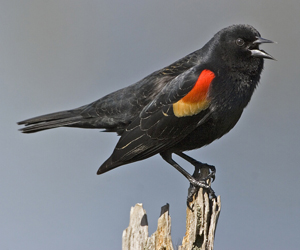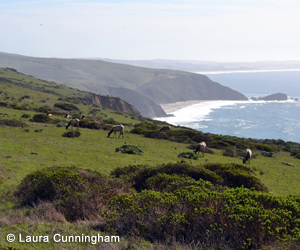
In April, 2018, California listed the Tricolored blackbird as a threatened species based on a dramatic decline in population.
Parks In Peril
Trump administration officials dismissed benefits of national monuments
Washington Post, July 23, 2018
Trump administration officials dismissed benefits of national monuments and accidentally released documents show officials instead emphasizing the value of logging and drilling.
Drilling in Alaska National Wildlife Refuge to get fast review
Washington Post, July 19, 2018
The Trump administration is moving ahead with its plans to open up the refuge’s coastal plain to energy exploration. An expedited environmental review allows three months to respond to hundreds of thousands of public comments.
Endangered Species Act stripped of key provisions in Trump administration proposal
Washington Post, July 19, 2018
The proposal would weaken a law enacted 45 years ago to keep plants and animals in decline from going extinct.
America’s lands are in danger. Help us fight the sell off.
The Guardian, June 5, 2017
“We’re here to unwind claims the federal government has on this land,” said Bundy, a Mormon cattle rancher in southern Nevada, after he and two dozen heavily armed militiamen forcibly took over the Malheur wildlife refuge, a central Oregon bird sanctuary, in January last year.
What is the Antiquities Act and Why Does Trump Want to Change It?
New York Times, April 27, 2017
Given the Trump administration’s recent actions — including lifting the moratorium on drilling on federal lands and the obligation to limit methane emissions on public lands — officials might be eyeing new fossil fuel leases on previously protected land.
Interior Dept takes step toward drilling in Alaska’s Arctic National Wildlife Refuge
USA Today, April 19, 2018
The Interior Department will start the environmental review process for setting up an oil and gas leasing program in the refuge’s 1.5-million-acre coastal plain.
National Parks are the Losers in Trump’s Budget and Infrastructure Proposals
Think Progress, February 13, 2018
Trump’s budget calls for extreme cuts to national parks.
America’s Public Lands Are in Danger
The Guardian, June 5, 2017
The Republican platform has opened the door to disposing of 640 million national acres.
Rancher’s Applaud President Trump’s “massive federal land grab.”
Fox News, May 2, 2017
Commercial Beef Cattle in America’s National Parks: Are You Serious?
National Parks and Conservation Association, July 3, 2012
More than a dozen of America’s national parks carry “grandfather clauses” that allow privately owned beef cattle to eat and trample national park resources while their owners pay just a token fee to lease these grazing privileges from the National Park Service.
Drilling in Alaska National Wildlife Refuge to get fast review
Washington Post, July 19, 2018
The Trump administration is moving ahead with its plans to open up the refuge’s coastal plain to energy exploration. An expedited environmental review allows three months to respond to hundreds of thousands of public comments.
Endangered Species Act stripped of key provisions in Trump administration proposal
Washington Post, July 19, 2018
The proposal would weaken a law enacted 45 years ago to keep plants and animals in decline from going extinct.
What is the Antiquities Act and Why Does Trump Want to Change It?
New York Times, April 27, 2017
Given the Trump administration’s recent actions — including lifting the moratorium on drilling on federal lands and the obligation to limit methane emissions on public lands — officials might be eyeing new fossil fuel leases on previously protected land.
Interior Dept takes step toward drilling in Alaska’s Arctic National Wildlife Refuge
USA Today, April 19, 2018
The Interior Department will start the environmental review process for setting up an oil and gas leasing program in the refuge’s 1.5-million-acre coastal plain.
National Parks are the Losers in Trump’s Budget and Infrastructure Proposals
Think Progress, February 13, 2018
Trump’s budget calls for extreme cuts to national parks.
America’s Public Lands Are in Danger
The Guardian, June 5, 2017
The Republican platform has opened the door to disposing of 640 million national acres.
Rancher’s Applaud President Trump’s “massive federal land grab.”
Fox News, May 2, 2017
Commercial Beef Cattle in America’s National Parks: Are You Serious?
National Parks and Conservation Association, July 3, 2012
More than a dozen of America’s national parks carry “grandfather clauses” that allow privately owned beef cattle to eat and trample national park resources while their owners pay just a token fee to lease these grazing privileges from the National Park Service.

What and Who Are Parks For?
Cattle Grazing At Point Reyes National Seashore Challenged In Lawsuit
National Parks Traveler, March 20, 2016
National Park Service Seeks to Ease Tensions with Pt Reyes Farmers
Los Angeles Times, May 26, 2014
The park service charges ranchers a grazing fee of just $7 a month for a cow and a calf. That fee on private land in neighboring communities ranges from $16 to $25. The homesteads where some ranch families live are leased to them by the park at less than market rates.
Ranchers Allowed 5-Year Extension to graze cattle in the Seashore
San Francisco Chronicle, July 13, 2017
The controversy has caused a split in Marin County over what constitutes good environmental practices — allow ranchers to let their cattle graze the grasslands, or leave the land in its most natural state without the pollution, erosion and other effects of grazing that impact native tule elk and other wildlife?
Determining the Future of Point Reyes Seashore
East Bay Express, May 2, 2018
Growing elk herds are competing with grazing cattle at the national park, raising questions about how best to manage public lands.
Point Reyes’ tule elk dilemma
San Francisco Chronicle, May 19, 2016
The largest land mammals native to California are fast becoming a common sight on coastal ranchland and along the rugged shoreline in Marin County. They are a symbol of conservation success at the 71,028-acre seashore, which draws nearly 3 million visitors a year. Many tourists come to the seashore specifically to see the magnificent creatures, which can weigh up to 800 pounds.
California drought causes cattle and elk to lock horns over pasture
Drovers, April 20,2015
Ranchers and farmers who live and work within the 71,000-acre (287-square km) Point Reyes National Seashore, 35 miles (56 km) northwest of San Francisco, want the free-roaming elk fenced in so their livestock do not have to compete for grass. Wildlife advocates and many park users are opposed after almost half of the majestic elks died while living in a 2,600-acre fenced-in area in the northern part of the park
Public lands belong to all Americans
Wildlands Defense
Public lands ranching is the most ubiquitous use of public lands in the country, occurring on over 250,000,000 acres of land, an area roughly the size of the states of California and Texas combined.

Early fall bloom of a yampah (Perideridia gairdneri and P. kelloggii) dominated prairie. Part of the coastal prairie restoration effort at Occidental Arts and Ecology Center in Occidental, CA.
Why Restore Point Reyes?
Wildlife Viewing In the California Coastal Prairies Of National Parks
National Parks Traveler, August 6, 2018
The Ten National Parks with the Most Endangered Species
National Conservation and Parks Association, May 2, 2018
National parks are critical for protecting the animals and plants that live in them, and no park denizens need that protection more than endangered species. According to the Endangered Species Act, an endangered species is an animal or plant in danger of extinction within the foreseeable future throughout all of a significant portion of its range.
The Sad Truth of Using Public Lands for Grazing
The Hill, March 30,2018
It is a well-known fact that livestock operations produce significant amounts of methane, a potent greenhouse gas. Converting deep-rooted perennial grasses native to the region to shallow-rooted annual grasses from Europe in livestock pastures also depletes the land’s ability to sequester carbon. While ranchers claim they’re trying to reduce their carbon footprint, in reality livestock removal is a far more effective option from a climate change standpoint.
Restoring California’s Coastal Ecosystems
Union of Concerned Scientists, April 13, 2017
The forces of urbanization and agriculture have made California’s coastal grassland and scrub ecosystems among the most endangered in the nation. The challenge is finding the balance between meeting the needs of people and conserving these ecosystems and the many species that depend on them, including humans.
Mending the Wild at Occidental Arts and Ecology Center
Fremontia, December 2016
Restoration can demonstrate, educate, and train communities about the various practices and experiments to establish a more regenerative relationship with our wildlands and watersheds.
On the Fence: How the recovery of tule elk has created a dilemma in wildlife management at Point Reyes
Bay Nature, October-December, 2015
This is the only national park to combine wilderness areas with ranching, and the debate over the elk is the latest example of the difficulties that can arise from incorporating a legacy of working landscapes into a national park.
Prairies and Grasses
National Park Service
Less than one percent of California’s native grassland is still intact today. By 1850, dairy ranchers had arrived at Point Reyes, lured by the near-ideal conditions for raising cattle. Since then, ranchers planted many non-native grasses, many of which were invasive and began to out-compete the native grasses.
Invasive Plants Changing Our Natural Ecosystems
National Park Service
Population Action International and Conservation International have determined that the California Floristic Province (CFP) is a “global biodiversity hotspot”-one of only 25 terrestrial regions worldwide where biological diversity is most concentrated and the threat of loss most severe (Cincotta and Engleman 2000; Conservation International 2007). Forty percent of California’s grass species are exotic; today it is rare to find a pristine native California coastal prairie community, and the dominance of exotic grasses over native bunch grass species could increase with global warming (Sandel and Dangremond 2012).
A Campaign to Restore California’s Coastal Prairie
Bay Nature, June 25, 2012
California’s coastal prairies are incredibly diverse, with nearly twice as many species as any other grassland in North America, many of which are endangered. During surveys, as many as 70 species could regularly be found in a single 10-meter-square plot.
“O
ur National Parks belong to each of us, and they are natural places to learn, exercise, volunteer, spend time with family and friends, and enjoy the magnificent beauty of our great land.”
